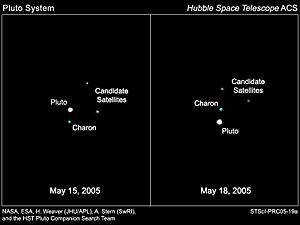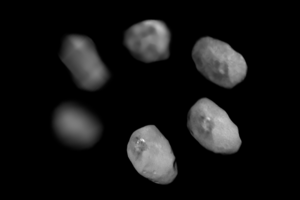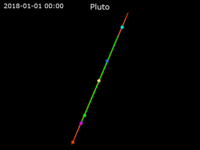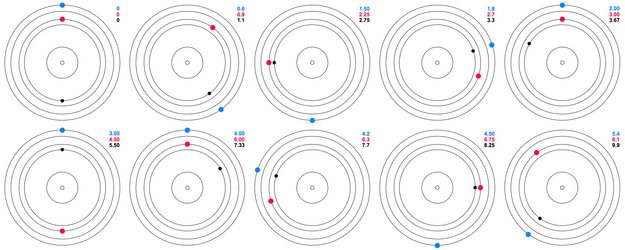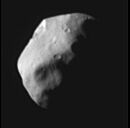Nix (moon) facts for kids
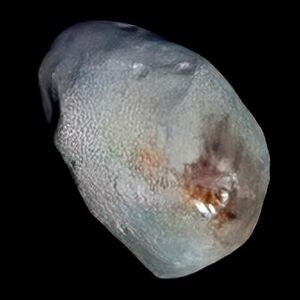
Enhanced color image of Nix, taken by New Horizons
|
|
| Discovery | |
|---|---|
| Discovered by | Hal A. Weaver et al. |
| Discovery date | 15 May 2005 |
| Designations | |
| MPC designation | Pluto II |
|
Named after
|
Nyx |
| S/2005 P 2 | |
| Adjectives | Nictian |
| Orbital characteristics | |
| 48694±3 km | |
| Eccentricity | 0.002036±0.000050 |
| 24.85463±0.00003 d | |
| Inclination | 0.133°±0.008° (122.53°±0.008° to Pluto's orbit) |
| Satellite of | Pluto |
| Physical characteristics | |
| Dimensions | 49.8 × 33.2 × 31.1 km (Geometric mean of 37 km) |
| Mass | (2.60±0.52)×1016 kg |
|
Mean density
|
1.031±0.204 g/cm3 |
| ≈ 0.0028 m/s2 at longest axis to ≈ 0.0072 m/s2 at poles |
|
| ≈ 0.0118 km/s at longest axis to ≈ 0.0149 km/s at poles |
|
| 1.829±0.009 d chaotic (decreased by 10% between discovery and flyby) | |
| 123°±10° (to Pluto–Charon orbit) 48°±10° (to celestial equator) |
|
|
North pole right ascension
|
350°±10° |
|
North pole declination
|
42°±10° |
| Albedo | 0.56±0.05 |
| 23.38–23.7 (measured) | |
| 8.28 | |
Nix is a small, natural moon of Pluto. It is about 49.8 km (30.9 mi) across at its longest point. Nix was found on May 15, 2005, along with Pluto's moon Hydra. Astronomers used the Hubble Space Telescope to discover them. Nix is named after Nyx, the Greek goddess of the night. It is the third moon from Pluto, orbiting between Styx and Kerberos.
The New Horizons spacecraft took pictures of Nix in July 2015. This happened when it flew past Pluto and its moons. These pictures show a large reddish area on Nix. This area is probably a big impact crater.
Contents
Discovering Nix
Max Mutchler and Andrew Steffl found Nix. They were part of the Pluto Companion Search Team. They used the Hubble Space Telescope to make this discovery. The New Horizons team thought Pluto and its moon Charon might have more moons. So, they used Hubble to look for faint moons in 2005.
Nix is much fainter than Pluto, about 5,000 times less bright. Because of this, they took long-exposure pictures to find it. The first discovery images were taken on May 15 and May 18, 2005. The discovery was announced on October 31, 2005. This was after they checked older Hubble images from 2002. The two new moons were first called S/2005 P 1 for Hydra and S/2005 P 2 for Nix. The discovery team often called them "P1" and "P2."
Naming the Moon
The International Astronomical Union (IAU) approved the name Nix. They announced it on June 21, 2006, along with Hydra's name. Nix is named after Nyx, the Greek goddess of darkness and night. In Greek mythology, Nyx is also the mother of Charon, the ferryman of Hades.
The names of the two new moons, Nix and Hydra, were chosen carefully. Their first letters, N and H, honor the New Horizons mission to Pluto. This is similar to how the first two letters of Pluto's name honor Percival Lowell. The original idea was to use the classical Greek spelling, Nyx. But to avoid confusion with the asteroid 3908 Nyx, the spelling was changed to Nix. This is the Coptic spelling of the name.
Names for features on Pluto's moons are often related to mythology. They also come from literature and the history of exploration. For Nix, features must be named after night deities from stories, myths, and history.
How Nix Formed
Scientists believe Pluto's smaller moons, including Nix, formed from a huge crash. This crash likely happened between Pluto and another object in the Kuiper belt. This idea is similar to how Earth's Moon is thought to have formed. Debris from the collision would have been thrown into space. This debris then came together to form Pluto's moons. However, this idea doesn't fully explain why Nix has such a bright, reflective surface.
What Nix is Like
Nix has an elongated shape. Its longest side is about 49.8 km (30.9 mi). Its shortest side is about 31.1 km (19.3 mi). So, its measurements are roughly 49.8 km × 33.2 km × 31.1 km (30.9 mi × 20.6 mi × 19.3 mi). It is the third-largest moon of Pluto, just a bit smaller than Hydra.
At first, some research suggested Nix's surface was reddish. But other studies show it is more neutral in color, like Pluto's other small moons. A neutral color means there is water ice on its surface. Nix also seemed to change in brightness and albedo, which is how much light it reflects. These changes in brightness were thought to be from areas with different reflectiveness on Nix's surface.
Pictures of Nix from the New Horizons spacecraft show a large reddish area. This area is about 18 km (11 mi) across. This could explain why earlier studies had different ideas about Nix's color. The reddish area might be a large impact crater. The reddish material could have been thrown out from under Nix's water ice layer. This material then settled on the surface. If so, Nix would have loose surface material, called regolith, from the impact. Another idea is that the reddish material came from a collision with another object that had a different makeup. However, other craters on Nix do not show such strong color changes.
The water ice on Nix's surface makes it very reflective. There might also be tiny amounts of frozen methane on its surface. This methane could be why the reddish material, likely tholins, is present. Tholins on Nix's surface might have formed when methane reacted with ultraviolet light from the Sun. By counting craters from New Horizons data, scientists think Nix's surface is at least four billion years old.
How Nix Rotates
Nix is not tidally locked, meaning it doesn't always show the same face to Pluto. Instead, it tumbles chaotically. This is similar to Pluto's other small moons. Nix's tilt and how fast it spins change a lot over short periods. Because of this chaotic rotation, Nix can even flip its entire rotational axis.
The changing gravity from Pluto and Charon causes this tumbling. They orbit around their shared barycenter (center of mass). Nix's elongated shape also makes its tumbling stronger. This shape creates forces that make it spin unevenly. When New Horizons flew by, Nix was spinning backward compared to Pluto's equator. Its rotation period was 43.9 hours, and its tilt was 132 degrees. Nix's rotation rate had increased by 10 percent since it was discovered.
Nix's Orbit
Nix orbits the Pluto-Charon barycenter about 48,694 km (30,257 mi) away. It orbits between Styx and Kerberos. All of Pluto's moons, including Nix, have very circular orbits. Their orbits are also flat, like Charon's orbit. This means they have very low orbital inclinations to Pluto's equator. The nearly circular and flat orbits suggest they changed over time due to tidal forces.
When Pluto's smaller moons first formed, Nix might have had a more eccentric (less circular) orbit. Charon's gravity likely made Nix's orbit more circular over time. This happened through tidal interactions. Charon would have pulled on Nix, making Nix transfer its orbital eccentricity to Charon. This made Nix's orbit gradually become more circular.
Nix takes 24.8546 days to orbit Pluto. Its orbit is connected to other moons of Pluto. Nix is in a 3:2 orbital resonance with Hydra. This means for every 3 times Hydra orbits, Nix orbits 2 times. It also has a 9:11 resonance with Styx. This "Laplace-like" resonance means Nix has specific alignments with Styx and Hydra in a 2:3 ratio.
Nix's orbit is also close to a 1:4 resonance with Charon. This means Nix orbits about four times for every one orbit of Charon. There is a small difference, so it's not a perfect resonance. Scientists think these near-resonances started before the moons moved outward from Pluto. They are kept stable by small changes in the Pluto–Charon gravity field.
Exploring Nix
The New Horizons spacecraft flew past the Pluto system on July 14, 2015. It took many pictures of Pluto and its moons. Of Pluto's smaller moons, only Nix and Hydra were photographed clearly enough to see details on their surfaces. Before the flyby, the Long Range Reconnaissance Imager (LORRI) on New Horizons measured Nix's size. It first estimated Nix to be about 35 km (22 mi) across.
The first detailed images of Nix were sent back from the spacecraft on July 18, 2015. They were released to the public on July 21, 2015. These images were taken from about 231,000 km (144,000 mi) away. Each pixel in the image showed about 3 km (1.9 mi) of Nix's surface. Nix's shape was often described as a "jelly bean." Enhanced color images from the Ralph MVIC instrument on New Horizons show a reddish area on its surface. From these images, scientists made a more accurate measurement of Nix's size. They found its dimensions to be about 42 km × 36 km (26 mi × 22 mi).
See also
 In Spanish: Nix (satélite) para niños
In Spanish: Nix (satélite) para niños


